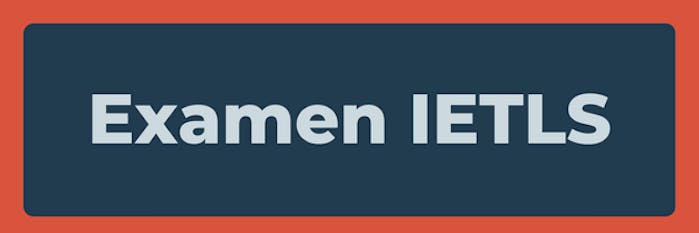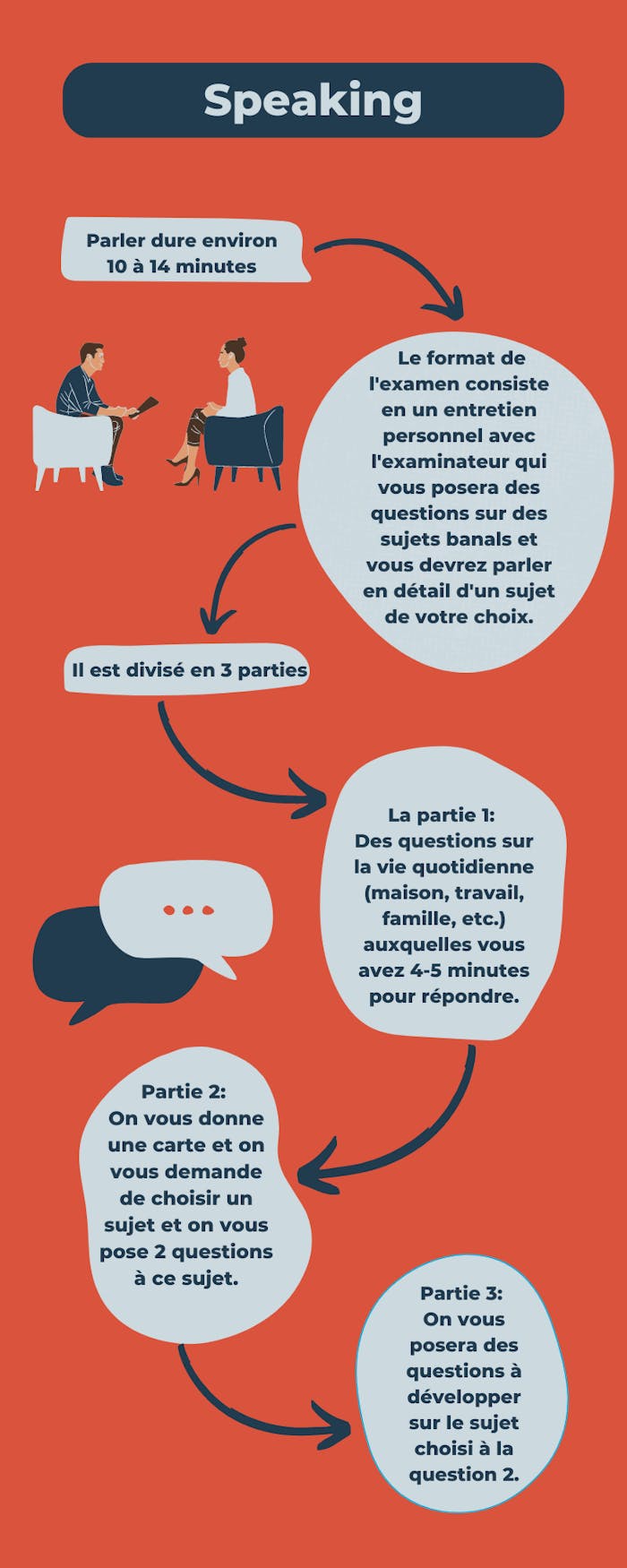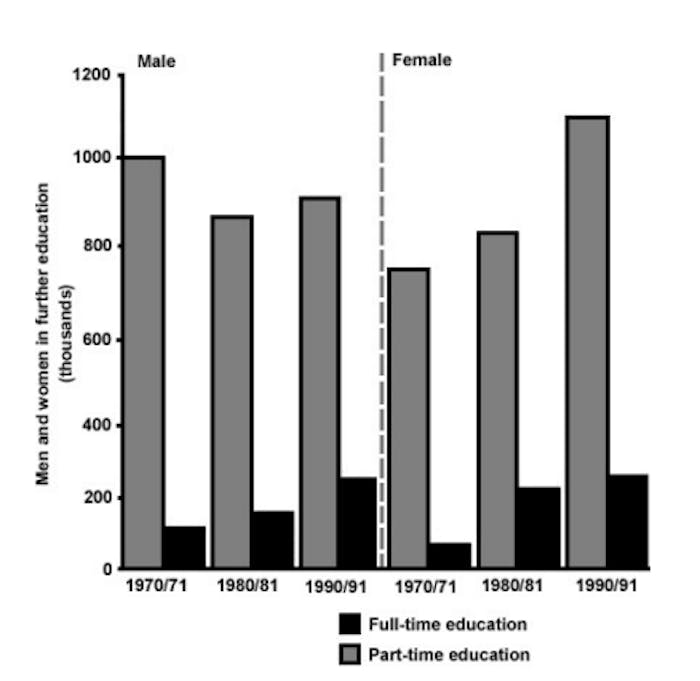Test IELTS: Simulation de test d'anglais, préparation, format et scores
L'examen IELTS: il a 3 versions, Académique, Formation Générale,IELTS UKVI et Life Skills. Ils ont tous une division en 4 parties semblable au TOEFL : Listening, Reading, Writing et Speaking. Les examens sont donnés dans des centres agréés et spécialisés.
Dans tous les cas, malgré le même format, ces 3 modèles d'examen ont un objectif différent et pour lequel ils sont donnés. Academic s'adresse à tous ceux qui souhaitent étudier dans des pays anglophones, General s'adresse à tous ceux qui souhaitent s'installer dans des pays anglophones,UK VI est d'immigrer au Royaume-Uni et Life Skills teste l'anglais de base.
Depuis Speakingathome nous pouvons vous aider afin que vous puissiez donner le meilleur de vous-même lorsque vous faites face à l'examen.

Format IELTS
L'évaluation, comme mentionné précédemment, est donnée en 4 parties:

L ’Reading a 60 minutes, 3 longs textes doivent être lus (Avec schémas, graphiques et illustrations), les textes peuvent varier de formats descriptifs et factuels, à discursifs et analytiques. Il comporte 40 questions créées pour tester l'éventail des compétences de compréhension en lecture du candidat, ergo la compréhension des idées principales, les détails, l'argument logique et la reconnaissance des opinions des auteurs du texte, des attitudes et du but. Les textes sont tirés d'articles de journaux, magazines, etc. et choisis parce qu'ils ne s'adressent pas à un public spécialisé.

L’Writing, d'une durée de 60 minutes, est divisée en 2 tâches : dans la première vous devez rédiger un document d'au moins 150 mots où vous devez résumer, expliquer ou décrire le texte fourni. Dans le second, vous devrez rédiger un essai dans lequel votre réponse est argumentée contre un point de vue, un argument ou une situation contradictoire et comporte un minimum de 250 mots.
Résultats IELTS
Les résultats aux examens sont les mêmes pour tous les types d'IELTS (académique, formation générale et IELTS UKVS), mais dans Life Skills, c'est réussite ou échec. La manière dont les examens sont notés va des notes (ou bandes) de 0 à 9.
Les notes, selon les résultats, peuvent être divisées en notes complètes (1,3,5) ou en demi-notes (2,5, 4,5 etc.). Les notes de qualification sont données comme suit :
- 9 : Utilisateur expert
- 8 : Très bon utilisateur
- 7 : Bon utilisateur
- 6 : Utilisateur compétent
- 5 : Utilisateur modeste
- 4 : Utilisateur limité
- 3 : Utilisateur très limité
- 2 : Utilisateur intermittent
- 1 : Aucun utilisateur
- 0 : N'a pas passé l'examen
Ces résultats comparés au Cadre Européen Commun de Référence (CEFR) seraient les suivants : 4 équivaut au niveau A2 limitrophe de B1, de 4,5 à 5 équivaut au niveau B1, 5,5 à 6,5 équivaut à B2, 7 à 8 équivaut à C1 et enfin de 8 à 9 il équivaut à un niveau C2 en anglais.
Préparation IELTS
Passer un examen n'est jamais facile, on a toujours le sentiment de ne jamais être suffisamment préparé, mais ces sentiments d'inadéquation peuvent toujours être résolus par un effort clair et constant.
Pour se préparer à l'examen IELTS, la plupart des académies anglaises recommandent de commencer à étudier environ 6 mois avant la date de l'examen. Étant donné que chaque section de l'examen nécessite une manière différente de se préparer.
Reading: Ce qui est nécessaire pour pouvoir se préparer à la lecture, c'est de pratiquer la compréhension écrite de textes, les règles d'orthographe, les règles verbales, etc. Il est recommandé de lire des textes en anglais, comme les sites d'actualités (bbc.com, etc.) si vous souhaitez avoir une connaissance générale de l'utilisation de la parole, mais vous pouvez également lire n'importe quelle page tant qu'elle est en anglais .
Writing: pour améliorer vos compétences en écriture, il est recommandé de sélectionner un sujet au hasard et d'essayer d'écrire de longs textes pendant 20 minutes au maximum, puis d'essayer de chronométrer votre temps de manière à ce qu'il soit de moins en moins long.
Listening: Pour la pratique de l'écoute, il est recommandé d'écouter des conférences en anglais pour former l'oreille, mais aussi écouter de la musique peut aider. Il n'est pas recommandé d'écouter des chansons qui ont un accent très fermé ou une forte utilisation du mot familier du musicien mais plutôt des chansons plus régulières comme celles de Frank Sinatra ou d'Elvis Presley.
Speaking: Si vous voulez parler couramment l'anglais, il est conseillé de communiquer avec des anglophones natifs. Une option est d'aller dans des bars où les immigrants anglophones traînent, mais il est préférable de suivre un cours en ligne pour s'entraîner.
Simulation d'examen IELTS
Il s'agit d'une simulation, l'expérience réelle peut varier.
Listening
PART 1
Questions 1 – 8 Complete the form below. Write NO MORE THAN THREE WORDS AND/OR A NUMBER for each answer.
PACKHAM’S SHIPPING AGENCY – customer quotation form
Name: Jacob 1 …………
Address to be collected from: 2 ………… College, Downlands Rd
Town: Bristol
Postcode: 3 …………
Size of container: Length: 1.5m Width: 4 ………… Height: 5 …………
Contents: Clothes 6 ………… 7 …………
Total estimated value: 8 £…………
Reading
This is an extract from an Academic Reading passage on the development of rockets. The text preceding this extract explored the slow development of the rocket and explained the principle of propulsion.
The invention of rockets is linked inextricably with the invention of 'black powder'. Most historians of technology credit the Chinese with its discovery. They base their belief on studies of Chinese writings or on the notebooks of early Europeans who
settled in or made long visits to China to study its history and civilisation. It is probable that, some time in the tenth century, black powder was first compounded from its basic ingredients of saltpetre, charcoal and sulphur. But this does not mean that it was immediately used to propel rockets. By the thirteenth century, powder propelled fire arrows had become rather common. The Chinese relied on this type of technological development to produce incendiary projectiles of many sorts, explosive grenades and possibly cannons to repel their enemies. One such weapon was the 'basket of fire' or, as directly translated from Chinese, the 'arrows like flying leopards'.
The 0.7 metre-long arrows, each with a long tube of gunpowder attached near the point of each arrow, could be fired from a long, octagonal-shaped basket at the same time and had a range of 400 paces. Another weapon was the 'arrow as a flying sabre', which could be fired from crossbows. The rocket, placed in a similar position to other rocket-propelled arrows, was designed to increase the range. A small iron weight was attached to the 1.5m bamboo shaft, just below the feathers, to increase the arrow's stability by moving the centre of gravity to a position below the rocket. At a similar time, the Arabs had developed the 'egg which moves and burns'. This 'egg' was apparently full of gunpowder and stabilised by a 1.5m tail. It was fired using two rockets attached to either side of this tail.
It was not until the eighteenth century that Europe became seriously interested in the possibilities of using the rocket itself as a weapon of war and not just to propel other weapons. Prior to this, rockets were used only in pyrotechnic displays. The incentive for the more aggressive use of rockets came not from within the European continent but from far-away India, whose leaders had built up a corps of rocketeers and used rockets successfully against the British in the late eighteenth century.
The Indian rockets used against the British were described by a British Captain serving in India as ‘an iron envelope about 200 millimetres long and 40 millimetres in diameter with sharp points at the top and a 3m-long bamboo guiding stick’. In the early nineteenth century the British began to experiment with incendiary barrage rockets. The British rocket differed from the Indian version in that it was completely encased in a stout, iron cylinder, terminating in a conical head, measuring one metre in diameter and having a stick almost five metres long and constructed in such a way that it could be
firmly attached to the body of the rocket. The Americans developed a rocket, complete with its own launcher, to use against the Mexicans in the mid-nineteenth century. A long cylindrical tube was propped up by two sticks and fastened to the top
of the launcher, thereby allowing the rockets to be inserted and lit from the other end. However, the results were sometimes not that impressive as the behaviour of the rockets in flight was less than predictable
Questions 1 – 3
Look at the following items (Questions 7-10) and the list of groups below. Match each item with the group which first invented or used them.
Write the correct letter A-E in boxes 7-10 on your answer sheet. NB You may use any letter more than once.
7 black powder
8 rocket-propelled arrows for fighting
9 rockets as war weapons
10 the rocket launcher
First invented or used by
A the Chinese
B the Indians
C the British
D the Arabs
E the Americans
Writing
TASK 1
You should spend about 20 minutes on this task.
The chart below shows the number of men and women in further education in Britain in three periods and whether they were studying full-time or part-time. Summarise the information by selecting and reporting the main features, and make comparisons where relevant
Write at least 150 words.
TASK 2
You should spend about 40 minutes on this task.
Write about the following topic:
Children who are brought up in families that do not have large amounts of money are better prepared to deal with the problems of adult life than children brought up by wealthy parents. To what extent do you agree or disagree with this opinion?
Give reasons for your answer and include any relevant examples from your own knowledge or experience. Write at least 250 words
Speaking
Part 1 Introduction and interview
[This part of the test begins with the examiner introducing himself or herself and
checking the candidate’s identification. It then continues as an interview.]
Let’s talk about your home town or village.
• What kind of place is it?
• What’s the most interesting part of your town/village?
• What kind of jobs do the people in your town/village do?
• Would you say it’s a good place to live? (Why?)
Let’s move on to talk about accommodation.
• Tell me about the kind of accommodation you live in?
• How long have you lived there?
• What do you like about living there?
• What sort of accommodation would you most like to live in?
Part 2 – Individual long turn
Candidate Task Card
Describe something you own which is very important to you.
You should say:
where you got it from
how long you have had it
what you use it for
and explain why it is important to you.
You will have to talk about the topic for 1 to 2 minutes.
You have one minute to think about what you're going to say.
You can make some notes to help you if you wish.
Rounding off questions
• Is it valuable in terms of money?
• Would it be easy to replace?
Part 3 – Two-way discussion
Let’s consider first of all how people’s values have changed.
• What kind of things give status to people in your country?
• Have things changed since your parents’ time?
Finally, let’s talk about the role of advertising.
• Do you think advertising influences what people buy?

